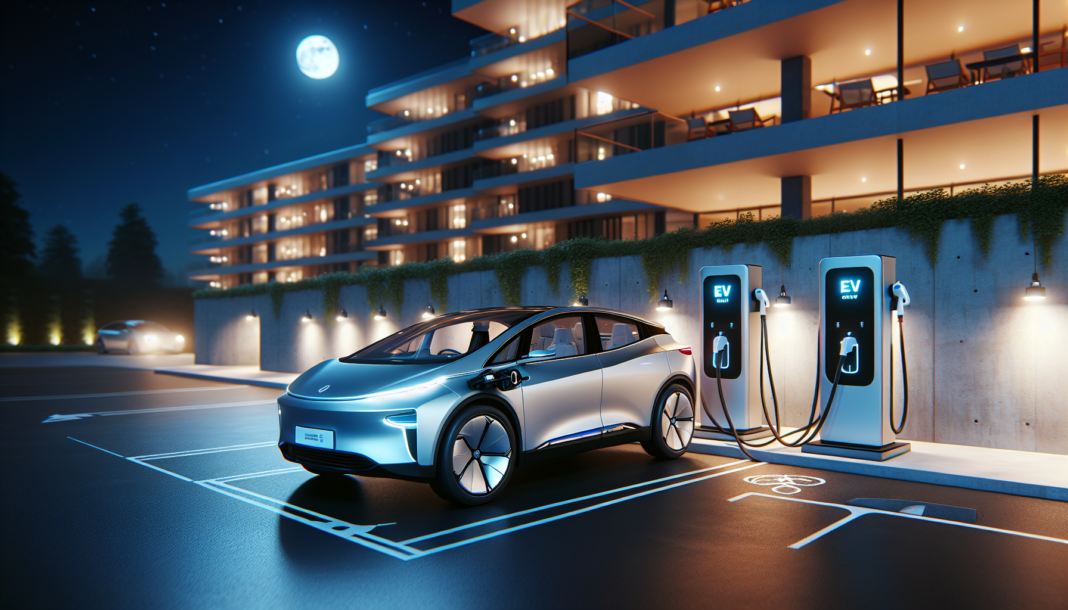Installing EV charging Condos is becoming a crucial amenity to attract and retain residents as the adoption of electric vehicles grows. These facilities not only enhance property value but also meet the increasing demand for convenient electric vehicle charging options for condo owners.
This article will cover the essentials of EV charging condos, including the benefits and challenges of adding EV charging stations, financial incentives, selecting the right EV charging solution provider, and steps for advocating for EV charging installation in your condo. Additionally, for those preparing for roles in the electric vehicle industry, familiarizing yourself with common Electric Vehicle Interview Questions can be beneficial. These questions often cover topics such as EV charging infrastructure, battery technology, and the integration of EV solutions in various environments, helping you to be well-prepared for job interviews in this rapidly evolving field.
Understanding the Basics of EV Charging Condos
Initial Steps for Installation
- Review Condo Rules: Start by understanding the specific regulations set by the condo association regarding modifications and installations.
- Inform the Condo Association: Communicate your intentions to install an EV charging station and gather necessary approvals.
- Identify a Suitable Location: Choose a location that is accessible and convenient for all potential users within the condo.
- Confirm Electrical Infrastructure: Ensure that the existing electrical system can support the additional load of an EV charger.
- Check for Required Permits: Obtain all necessary permits from local authorities to ensure compliance with regulations.
- Choose Compatible Equipment: Select an EV charger that is compatible with most electric vehicles and fits the physical constraints of the installation site.
- Obtain Approvals and Inspections: Secure final approvals from the condo association and schedule inspections to ensure everything is up to code.
Legal Considerations
- Right to Charge Laws: In some regions, like California, laws such as Civil Code Section 4745 support the installation of EV charging stations in condos, provided certain conditions are met. This can simplify the approval process.
Financial Responsibilities
- Determining Payment: The cost of installing an EV charging station can be handled by individual users, the condo association, or through cost-sharing arrangements. This depends largely on the expected usage and ownership structure.
Essential Features for Condo EV Charging Stations
- Design and Connectivity: Opt for a wall-mounted, compact design with smart connectivity features for ease of use and maintenance.
- User Authentication and Billing: Include user authentication capabilities along with metering and billing options to manage usage and costs effectively.
- Safety and Compatibility: Ensure the EV charging station has necessary safety features and is compatible with multiple EV models to accommodate all residents.
Payment Options for Electricity Usage
- Methods of Payment: Residents can pay for the electricity used by the EV charging stations through various methods such as individual metering, subscription services, pay-per-use, third-party billing, or subsidized charging programs.
Understanding Different Levels of Charging
- Level 1 and Level 2 Charging: These are the most feasible options for condos, offering a balance between charging speed and installation cost.
- Level 3 Charging: Often not suitable for condos due to higher costs and more complex installation requirements.
By following these guidelines, condo residents and associations can effectively plan and implement EV charging solutions that cater to the needs of electric vehicle owners while adhering to legal and financial considerations.
The Need for EV Charging in Condos
The growing demand for electric vehicles (EVs) underscores the necessity for EV charging stations in condominiums. As EV ownership increases, driven by environmental concerns and advancements in technology, residents are seeking properties that support their sustainable lifestyle choices. This shift is influencing real estate dynamics, compelling landlords and condo associations to adapt by installing EV charging facilities.
Tenant Demand and Market Trends
- Rising EV Ownership: Projections indicate that EVs could account for 40-50% of all passenger vehicle sales in the U.S. by 2030. This surge in EV ownership creates a pressing need for accessible charging options in residential areas, including condos.
- Attracting and Retaining Residents: Condos equipped with EV charging stations are more attractive to potential tenants who own or plan to own electric vehicles, significantly boosting the property’s appeal and competitive edge in the housing market.
Legal and Regulatory Drivers
- State Laws and Regulations: Various states have enacted “Right to Charge” laws that support the installation of EV chargers in multi-unit dwellings by preventing homeowners associations (HOAs) from outright banning them. These laws ensure that EV owners have the necessary infrastructure to support their vehicles.
Financial Incentives and Property Value
- Tax Credits and Rebates: Property owners can benefit from federal tax credits up to $30,000 for the installation of EV charging stations, reducing the financial burden and encouraging more widespread adoption.
- Enhanced Property Value: Properties with EV charging stations tend to have higher resale values and attract tenants more quickly than those without, providing a tangible return on investment.
Sustainability and Corporate Responsibility
- Environmental Impact: By facilitating the use of electric vehicles, condos contribute to reduced carbon emissions and support broader environmental goals, aligning with increasing public and governmental emphasis on sustainability.
Revenue Opportunities
- Charging for Services: Condo associations can create new revenue streams by installing EV chargers and offering charging services to residents, either as part of the HOA fees or through pay-per-use models.
The integration of EV charging stations in condos not only meets current tenant demands but also positions properties for future growth and compliance with evolving environmental standards.
Benefits of Adding EV Charging to Your Condo
Attracting and Retaining Tenants
- Appeal to EV Owners: Condos with EV charging stations attract tenants who own or plan to own electric vehicles, ensuring a competitive edge in the market.
- Enhanced Tenant Retention: Providing essential amenities like EV charging can increase tenant satisfaction and retention rates.
Financial Benefits
- Revenue Generation: Charging a fee for EV charging usage introduces a new revenue stream for the property.
- Increased Property Value: The installation of EV charging stations can significantly raise the property’s market value.
Sustainability and Market Competitiveness
- Support for Green Living: Facilitates sustainable practices, attracting environmentally conscious tenants.
- Fulfillment of Sustainability Goals: Helps in meeting environmental commitments and improving the condo’s sustainability profile.
- Staying Ahead in the Market: Ensures the property remains attractive and competitive, especially against newer developments that offer similar amenities.
Access to Incentives
- Financial Incentives: Owners may access various subsidies, including tax credits, which can offset the installation costs of EV charging stations.
Enhancing Condo Appeal
- Sought-After Amenity: As EV ownership increases, having an EV charger becomes a significant draw for potential residents.
- Long-Term Attractiveness: Continuously attracts a demographic of eco-conscious residents who consider such infrastructure essential.
This integration of EV charging facilities not only meets the current needs of residents but also positions the property for future growth and relevance in an increasingly eco-aware market.
Challenges and Solutions for Implementing EV Charging in Condos
Open Communication and Stakeholder Engagement
- Identify Stakeholders: Recognize all parties involved, from condo residents to management companies.
- Engage Regularly: Hold meetings to discuss plans, concerns, and expectations.
- Gather Feedback: Use surveys or informal discussions to understand resident needs and preferences.
Navigating Legal and Technical Requirements
- Permit Acquisition: Research local laws and obtain necessary permits for installation.
- Technical Assessments: Assess the building’s electrical capacity and infrastructure needs.
Financial Planning and Management
- Budgeting: Estimate costs for purchase, installation, and ongoing maintenance.
- Seek Financial Aid: Explore rebates, grants, and incentives to offset initial costs.
Installation and Technology Solutions
- Choose the Right Technology: Opt for smart chargers with load management to prevent power disruptions.
- Professional Installation: Use certified electricians and follow all safety standards.
Operational Strategies and User Management
- Implement User Policies: Establish rules for charger use, such as reservation systems and time limits.
- Transparent Billing: Set up a clear billing system to manage electricity costs among users.
Overcoming Space and Power Limitations
- Maximize Space: Strategically plan the layout to accommodate as many chargers as possible.
- Upgrade Infrastructure: If necessary, invest in upgrading the electrical system to support additional load.
By addressing these challenges with thoughtful solutions, condos can successfully integrate EV charging stations, enhancing the property’s value and resident satisfaction.
Financial Incentives and Rebates for EV Charging Installation
Federal and State Incentives
- Federal Tax Credits: Property owners can take advantage of a federal tax credit that covers 30% of the costs associated with the installation of qualifying EV charging stations.
- State and Local Programs: Various states and municipalities offer additional incentives, such as rebates and grants, to encourage the installation of EV charging infrastructure. For example, California provides credits for lower-carbon energy solutions.
Utility and Government Grants
- Utility Company Offers: Some utility companies provide credits and rebates for the installation of EV chargers. Checking the Database of State Incentives for Renewables & Efficiency can reveal opportunities specific to your location.
- EPA and DOT Grants: The EPA offers substantial funding for the deployment of EV infrastructure in various sectors, including schools and ports. Similarly, the DOT has allocated billions for enhancing EV charging capabilities across the nation.
Special Programs for Specific Sectors
- HUD Programs: These programs are designed to help lower-income properties integrate energy-efficient technologies like EV charging stations.
- EPA Clean School Bus Programs: These initiatives provide significant funding to update school transportation to cleaner technologies, including the installation of EV chargers.
Understanding Costs and Maximizing Incentives
- Initial Cost Analysis: Installing EV chargers during new construction can be significantly cheaper than retrofitting, saving thousands per charging spot.
- Long-term Benefits: Besides the immediate financial incentives, adding EV charging stations can increase property values and attract eco-conscious tenants, ensuring long-term profitability.
Selecting the Right EV Charging Solution Provider
When considering the installation of EV charging stations at a condo, selecting the right EV charging solution provider is crucial. Here are some key points to guide you through the process:
Key Considerations for Choosing a Provider
- Compatibility and Safety: Ensure that the EV charging stations are compatible with a wide range of electric vehicles and adhere to safety standards.
- Future-proof Technology: Opt for chargers that offer smart and bidirectional charging capabilities to accommodate future advancements in EV technology.
- Professional Installation: Always use certified installers to handle the installation of EV chargers to ensure safety and compliance with local regulations.
Cost and Operational Management
- Charging Equipment Cost: High-quality EV chargers typically range from €750 to €1500.
- Installation and Maintenance: Factor in the costs for professional installation and ongoing maintenance to avoid future complications.
Legal and Permitting Issues
- Permitting Process: Identify the local government office responsible for permitting EV charger installations, typically found under public works or transportation/environment departments.
By carefully selecting a provider that meets these criteria, condo associations can ensure a successful and sustainable integration of EV charging stations into their properties.
Steps to Advocate for EV Charging in Your Condo
Engage with the Community
To initiate the advocacy for EV charging stations in your condo, start by engaging with your community. This can be done through organized surveys, community meetings, or informal conversations. Understanding the level of interest and support among the residents is crucial for moving forward.
Form a Committee
If there is noticeable interest, consider forming a committee dedicated to this cause. This group can spearhead the efforts, conducting detailed research on EV charging solutions and liaising with the condo board effectively.
Present a Proposal
Once the committee is formed and the necessary information is gathered, develop a comprehensive proposal. This should outline the benefits of installing EV charging stations, tailored to the specific needs and capabilities of your condo. Include potential installation solutions and emphasize the added value to the property.
Legal Support and Building Codes
Highlight the support of Right-to-Charge laws that prevent unreasonable blockages from homeowners associations or landlords, ensuring residents can install their EV chargers if they bear the costs. Also, reference new building codes that mandate EV-ready parking spaces in all new constructions, reinforcing the inevitability of this upgrade.
Follow Up
After presenting the proposal, maintain communication with the condo board to track the progress of your request. Regular follow-ups will keep the proposal active in discussions and help address any emerging concerns or questions.
By following these steps, residents can effectively advocate for the integration of EV charging stations in their condos, enhancing convenience for current and future electric vehicle owners.
Installation and Maintenance of EV Charging Stations
Installation Process
- Preliminary Check: Schedule an initial assessment to evaluate the electrical infrastructure and suitability of the proposed location for EV chargers.
- Service Assessment: Contact a professional electrical contractor or a car dealership knowledgeable about EV installations to ensure that all technical requirements are met.
- Submit Request Form: Fill out and submit a Commercial or Residential EV Charging Station Request Form to get the necessary approvals from local authorities or the condo management.
Cost Considerations
- Up-front Costs: Address the reluctance of both landlords and tenants to bear the initial expenses by exploring financial incentives and demonstrating long-term benefits.
- Property Turnovers: Mitigate concerns related to quick turnovers in multifamily residences by emphasizing the increased property value and appeal to prospective tenants.
- Tenant Mobility: For tenants unsure about long-term residency, highlight the benefits of enhanced property features that boost rental and resale value.
Equity-Centered Installation
- EV-Ready Parking: Ensure each unit has access to at least one EV-ready parking spot, equipped with low-power Level 2 charging capabilities.
- Direct Wiring: Connect charging receptacles directly to each tenant’s electrical panel to facilitate individual billing and reduce common area charges.
- Signage: Install clear signage to indicate the EV-ready status of parking spaces, enhancing visibility and accessibility for all residents.
Billing and Maintenance
- Meter Tap Method: Implement the meter tap method for billing, where electricity usage is connected directly to the tenant’s meter, ensuring accurate and individual billing without complex payment systems.
- Maintenance Plans: Set up regular maintenance schedules with certified technicians to ensure the charging stations are always operational and safe.
By following these guidelines, condos can efficiently integrate EV charging stations, providing a valuable amenity to residents and enhancing the overall appeal and functionality of the property.
Conclusion
The installation of EV charging stations in condominiums represents a forward-thinking initiative that not only caters to the current needs of eco-conscious residents but also equips properties for future demands and sustainability goals. Through a comprehensive exploration of the benefits, challenges, and necessary steps for installing EV charging facilities, this article has underscored the significance of such amenities in enhancing property value, attracting and retaining tenants, and fostering a greener environment. By adhering to the outlined guidelines and harnessing available financial incentives, condo residents and associations can navigate the complexities of implementation, ensuring a smooth transition to more EV-friendly living spaces.
As the momentum towards electric vehicles continues to build, the provision of EV charging stations in condos emerges as an indispensable amenity that aligns with evolving tenant preferences and environmental standards. This endeavor not only reflects a commitment to sustainability but also offers tangible benefits in terms of property appeal and competitive edge in the real estate market. By embracing the steps and solutions presented, condos can effectively position themselves at the forefront of the green living movement, promising a cleaner, more sustainable future for all residents.
FAQs
Q: What are the steps for setting up an electric vehicle (EV) charging station in a condominium?
A: When planning to set up an EV charging station in a condominium, you should first get approval from your condo association. Then, identify a suitable location for the charger and consult a licensed electrician to assess the electrical capacity. After selecting an appropriate charging solution, acquire the necessary permits and proceed with the installation of the charger.
Q: What are the proper manners to follow when using an EV charging station?
A: Proper EV charging etiquette involves parking at the station only while your vehicle is charging. Once your vehicle is fully charged or reaches the desired charge level, as indicated by your app, you should promptly move it. It’s important not to treat EV charging spots as regular parking spaces.
Q: Is it mandatory for condominium associations in Florida to facilitate the installation of EV charging stations for residents?
A: Yes, recent Florida laws mandate that condominium associations must accommodate residents’ requests to install EV charging stations. The costs associated with the installation and maintenance of the charging infrastructure are the responsibility of the residents who request the service.
Q: What should I know about the process of charging an electric car at home?
A: To charge an electric car quickly at home, you should consider installing a Level 2 charging station. This type of station can be placed on the side of your house, in a garage, or in a private parking area. It requires a direct connection to your home’s electrical supply and often necessitates installation by a certified electrician.


